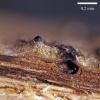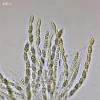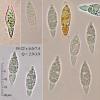
04-11-2025 09:07
Hello.A suspected Hymenoscyphus sprouting on a thi

04-11-2025 12:43
 Edvin Johannesen
Edvin Johannesen
Hi! One more found on old Populus tremula log in O

03-11-2025 21:34
 Edvin Johannesen
Edvin Johannesen
These tiny (0.4-0.5 mm diam.), whitish, short-stip

28-10-2025 15:37
Carl FarmerI'd be grateful for any suggestions for this strik

03-11-2025 16:30
 Hans-Otto Baral
Hans-Otto Baral
Hello I want to ask you if you have found this ye

28-10-2025 19:33
 Nicolas Suberbielle
Nicolas Suberbielle
Bonjour à tous,Je voudrais votre avis sur cette r
I'd like to know your opinion about this (I think) Anthostomella species growing on small branches (20 mm broad) of Fraxinus excelsior lying on the ground, at the sea level (Botanical Garden of Gijón/Asturias/Spain).
The inmersed, gregarious, blackish, roundish or elliptical perithecia, 1.20-1.35 microns in diam., are singly, in pairs or small groups just beneath the bark with only the short necks protruding. Many times an stromatized blackish clypeoid structure is present over the perithecia.
Asci cylindrical, 145-155 x 7.5-8,5, unitunicate, with an apical cylindrical apparatus up to 3 microns long, deeply blueing in IKI, with 8 more or less uniseriate 2-celled ascospores that seem to have very small caps at the poles (that are not well visible in china ink). These ascospores, close to those of A. rubicola, are allways hyaline or only a few of them at most slightly brownish inside the asci.
I don't know any species that fits with my fungus
Have you any idea?
Thanks again

I have seen two collections of your fungus from France, one on Quercus ilex twigs collected by Paul Leroy, the other one on Acer twigs by C. Lechat. Very few ascospores develop a pale brown cell lacking a germ slit, just like in A. rubicola. Likely an undescribed lignicolous counterpart of A. rubi, as you suggested. Frustrating.
Cheers,
Jacques
Thanks again, Jacques
There exists some pyreno that you have not seen? I think not...
My material will be keeped in my herbarium. Maybe you will need it...
Hi Jacques
How did you describe the small polar caps of the ascospores? Had your spores these elements?

An important differential character from A. rubi migght be the tendency to cluster in small groups and to have well differentiated papillate ostioles.
Jacques


Jacques






